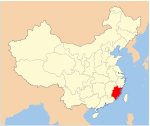Huangjin Gui
| Huangjin Gui | |
|---|---|
 | |
| Type | Oolong |
|
| |
| Other names | Golden Osmanthus, Golden Cassia |
| Origin | Anxi County, Fujian Province, China |
|
| |
| Quick description | Similar to Tieguanyin with a fruity taste and aroma |
|
| |
| Temperature | 90-95°C |

Huangjin Gui (simplified Chinese: 黄金桂; traditional Chinese: 黃金桂; pinyin: huángjīn guì; pronounced [xwǎŋtɕín kwêi]) is a premium variety of Chinese oolong tea traditionally from Anxi in Fujian province. Named after the yellow golden color of its budding leaves and its unique flowery aroma, said to be reminiscent of Osmanthus.[1]
This oolong is similar to Tieguanyin, with only a little oxidation. Consequently, it has a very flowery, delicate aroma without the astringency of a green tea or the heaviness of a Red/Black Tea.
Legends
There are two legends behind this tea: Wang/Marriage legend and the legend of farmer Wei.
Wang legend
The first is that this tea originated from two seeds given to Lin Ziqin by Wang Danwei from an ancestral temple on their wedding day. The plants that grew were to represent the prosperity of their ancestors and families uniting. The tea produced from these had a unique golden color and fragrance like osmanthus. As a result, it is often given as a wedding present.
Wei legend
The other story is that a tea farmer named Wei Zhen was strolling by a brook when he noticed a golden plant on the horizon. As a tea farmer he felt obligated to take a sample and cultivate it. To his surprise it had the fragrance of osmanthus and arich gold color remained.[2]
Both legends date its origins back to about the mid nineteenth century.
References
- ↑ Helen Saberi (2010). Tea: A Global History. Reaktion Books. p. 14. ISBN 9781861898920. Retrieved 17 May 2018.
- ↑ 黄金桂历史